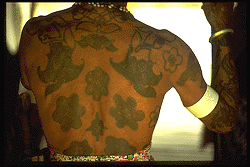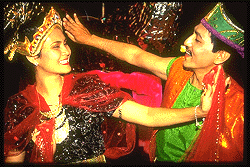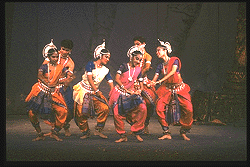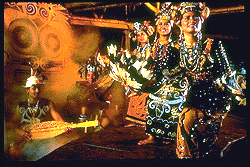| LinkExchange Member | Free Home Pages at GeoCities |
| LinkExchange Member | Free Home Pages at GeoCities |

| Cultures have been meeting and mixing in Malaysia since the very beginning of its history. More than fifteen hundred years ago a Malay kingdom in Bujang Valley welcomed traders from China and India. With the arrival of gold and silks, Buddhism and Hinduism also came to Malaysia. A thousand years later, Arab traders arrived in Malacca and brought with them the principles and practices of Islam. By the time the Portuguese arrived in Malaysia, the empire that they encountered was more cosmopolitan than their own. |  Tattooed Iban Warrior from Sarawak |
Malaysia's cultural mosaic is marked by many different cultures, but four in particular have had especially lasting influence on the country: indigenous Malay culture, and the cultures of Malaysia's three most prominent trading partners throughout history--the Chinese, the Muslim Arabs, and the Indians. Although each of these cultures has vigorously maintained its traditions and community structures, they have also blended together to create contemporary Malaysia's uniquely diverse heritage.
One example of the complexity with which Malaysia's immigrant populations have contributed to the nation's culture as a whole is the history of Chinese immigrants. The first Chinese to settle in the straits, primarily in and around Malacca, gradually adopted elements of Malaysian culture and intermarried with the Malaysian community. Known as babas and nonyas, they eventually produced a synthetic set of practices, beliefs, and arts, combining Malay and Chinese traditions in such a way as to create a new culture. Later Chinese, coming to exploit the tin and rubber booms, have preserved their culture much more meticulously. A city like Penang, for example, can often give one the impression of being in China rather than in Malaysia.
 Another example of Malaysia's extraordinary
cultural exchange the Malay wedding ceremony, which incorporates
elements of the Hindu traditions of southern India; the bride and
groom dress in gorgeous brocades, sit in state, and feed each
other yellow rice with hands painted with henna. Muslims have
adapted the Chinese custom of giving little red packets of money
(ang pau) at festivals to their own needs; the packets given on
Muslim holidays are green and have Arab writing on them.
Another example of Malaysia's extraordinary
cultural exchange the Malay wedding ceremony, which incorporates
elements of the Hindu traditions of southern India; the bride and
groom dress in gorgeous brocades, sit in state, and feed each
other yellow rice with hands painted with henna. Muslims have
adapted the Chinese custom of giving little red packets of money
(ang pau) at festivals to their own needs; the packets given on
Muslim holidays are green and have Arab writing on them.
You can go from a Malaysian kampung to a rubber plantation worked by Indians to Penang's Chinese kongsi and feel you've traveled through three nations. But in cities like Kuala Lumpur, you'll find everyone in a grand melange. In one house, a Chinese opera will be playing on the radio; in another they're preparing for Muslim prayers; in the next, the daughter of the household readies herself for classical Indian dance lessons.
Perhaps the easiest way to begin to understand the highly complex cultural interaction which is Malaysia is to look at the open door policy maintained during religious festivals. Although Malaysia's different cultural traditions are frequently maintained by seemingly self-contained ethnic communities, all of Malaysia's communities open their doors to members of other cultures during a religious festival--to tourists as well as neighbours. Such inclusiveness is more than just a way to break down cultural barriers and foster understanding. It is a positive celebration of a tradition of tolerance that has for millenia formed the basis of Malaysia's progress.

Perhaps the best known Malaysian theater event is the wayang kulit. Before the encroachment of television, the wayang kulit, or shadow puppet play, was the favorite after-dark entertainment. The enang, as the puppeteer was called, directed the puppets' intricate movements while singing dozens of parts in a performance which often lasted several hours. The wayang kulit draws its inspiration from the Ramayana, the Hindi epic comprised of a potpourri of immortal tales. The wayang kulit throws in a handful of Javanese and Malay characters for good measure and then pits good against evil in a classic plot. Warrior animals, giants, ghouls, princes, and priests battle it out to the finish in this rousing epic.

Music and dance are almost inseparable in the Malaysian culture. Where there is one, the other is not far behind. True to Malaysia's heritage, dances vary widely and are, if not imports direct from the source nation, heavily influenced by one or more of Malaysia's cultural components. Much of Malaysian music and dance has evolved from more basic needs into the mesmerizing, complex art forms they are today.
 Traditional music is centered around the gamelan, a
stringed instrument from Indonesia with an otherworldly, muffled
sound. The lilting, hypnotic beats of Malaysian drums accompany
the song of the gamelan; these are often the background for court
dances. Malaysia's earliest rhythms were born of necessity. In an
age before phone and fax, the rebana ubi, or giant drums, were
used to communicate from hill to hill across vast distances.
Wedding announcements, danger warnings, and other newsworthy
items were drummed out using different beats. The rebana ubi are
now used primarily as ceremonial instruments. The Giant Drum
Festival is held in Kelantan either in
May or June.
Traditional music is centered around the gamelan, a
stringed instrument from Indonesia with an otherworldly, muffled
sound. The lilting, hypnotic beats of Malaysian drums accompany
the song of the gamelan; these are often the background for court
dances. Malaysia's earliest rhythms were born of necessity. In an
age before phone and fax, the rebana ubi, or giant drums, were
used to communicate from hill to hill across vast distances.
Wedding announcements, danger warnings, and other newsworthy
items were drummed out using different beats. The rebana ubi are
now used primarily as ceremonial instruments. The Giant Drum
Festival is held in Kelantan either in
May or June.
Similarly, silat, an elegant Malaysian dance form, originated as a deadly martial art. The weaponless form of self-defense stripped fighting to a bare minimum. Silat displays are common at weddings and other festivals; the dancer will perform sparring and beautiful routines to accompanying drums and other musical instruments.
 The candle dance is one of Malaysia's most
breathtakingly beautiful perfromance arts. Candles on small
plates are held in each hand as the dancer performs. As the
performer's body describes graceful curves and arcs, the delicate
candle flames become hypnotic traces.
The candle dance is one of Malaysia's most
breathtakingly beautiful perfromance arts. Candles on small
plates are held in each hand as the dancer performs. As the
performer's body describes graceful curves and arcs, the delicate
candle flames become hypnotic traces.
The Joget, Malaysia's most popular traditional dance, is a lively dance with an upbeat tempo. Performed by couples who combine fast, graceful movements with rollicking good humor, the Joget has its origins in the Portuguese folk dance, which was introduced to Malacca during the era of the spice trade.
Among the many different traditional theatres of the Malays, which combine dance, drama, and music, no other dance drama has a more captivating appeal than Mak Yong. This ancient classic court entertainment combines romantic stories, operatic singing and humor.
 The Datun Julud is a popular dance of Sarawak, and
illustrates the age-old tradition of storytelling in dance. The
Datun Jalud tells of the happiness of a prince when blessed with
a grandson. It was from this divine blessing that the dance
became widespread among the Kenyah tribe of Sarawak. The Sape, a
musical instrument, renders the dance beats, which are often
helped along by singing and clapping of hands.
The Datun Julud is a popular dance of Sarawak, and
illustrates the age-old tradition of storytelling in dance. The
Datun Jalud tells of the happiness of a prince when blessed with
a grandson. It was from this divine blessing that the dance
became widespread among the Kenyah tribe of Sarawak. The Sape, a
musical instrument, renders the dance beats, which are often
helped along by singing and clapping of hands.
Although Malaysia's cultural heritage is rich and varied almost beyond belief, it would be a mistake to assume that heritage to be wholly traditional. Malaysia has joined the recent world music trend by updating many of its beautiful traditional sounds. Modern synthesizers accompany the gamelan and the drums for a danceable, hypnotic sound you won't soon forget.

 In a world where nature provided for many of
humankind's needs, leisure was honed to an art form. Much of
Malaysian leisure time is occupied by elaborate competitions.
Kite-flying is a favorite among participants and spectators
alike. Kites, called waus, are painstakingly designed and crafted
in vibrant colors and patterns. Intricate floral cutouts are
pasted on, building up the design until the kite is ready for the
bright paper tassels that complete its decoration. Kite
construction is an ancient art passed down from the nobles of the
Melakan court. Over the dried padi fields, a wau bulan, or moon
kite, catches an upcurrent of air. Its wing span is larger than
that of an albatross. What used to be a post-harvest diversion
among padi farmers has become an international event. Wau
festivals are organized each year and draw participants from as
far away as the Netherlands, Japan, Germany, Belgium, and
Singapore.
In a world where nature provided for many of
humankind's needs, leisure was honed to an art form. Much of
Malaysian leisure time is occupied by elaborate competitions.
Kite-flying is a favorite among participants and spectators
alike. Kites, called waus, are painstakingly designed and crafted
in vibrant colors and patterns. Intricate floral cutouts are
pasted on, building up the design until the kite is ready for the
bright paper tassels that complete its decoration. Kite
construction is an ancient art passed down from the nobles of the
Melakan court. Over the dried padi fields, a wau bulan, or moon
kite, catches an upcurrent of air. Its wing span is larger than
that of an albatross. What used to be a post-harvest diversion
among padi farmers has become an international event. Wau
festivals are organized each year and draw participants from as
far away as the Netherlands, Japan, Germany, Belgium, and
Singapore.
 The pre-harvest counterpart to the
post-harvest wau-flying is top-spinning, a game requiring great
strength, excellent timing, and dexterity. These are not
childrens' toys. A gasing, or spinning top, can weigh up to ten
pounds and can sometimes be as large as a dinner plate. Gasing
competitions are judged by the length of time each top spins. The
tops are set spinning by unfurling a rope that has been wound
about the top. A gasing expert can set one spinning for over an
hour.
The pre-harvest counterpart to the
post-harvest wau-flying is top-spinning, a game requiring great
strength, excellent timing, and dexterity. These are not
childrens' toys. A gasing, or spinning top, can weigh up to ten
pounds and can sometimes be as large as a dinner plate. Gasing
competitions are judged by the length of time each top spins. The
tops are set spinning by unfurling a rope that has been wound
about the top. A gasing expert can set one spinning for over an
hour.
Silat is at once a fascinating, weaponless Malay art of self defense and also a dance form that has existed in the Malay Archipelago for hundreds of years. Like the best martial arts, silat is often more about the spirit than the body. The silat practitioner also develops spiritual strength, according to the tenets of Islam.
In an age when many of the martial arts are dying out, young people are especially drawn to this art--there are countless silat groups in Malaysia, each with their own style. Silat demonstrations are held during weddings, national celebrations, and of course during silat competitions.
Sepak Takraw is one of Malaysia's most popular sports. In a
game reminiscent of hackey-sack (or perhaps the source for it),
players use heels, soles, in-steps, thighs, shoulders and
heads--everything but hands--to keep the small rattan ball aloft.

[Culture] [Main Page][Myths & Legends]
[Festival] [Terms] [Credits]
[Sign Guestbook] [View Guestbook]